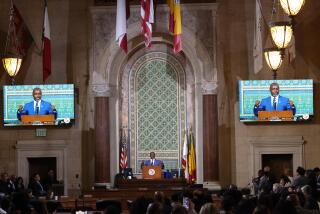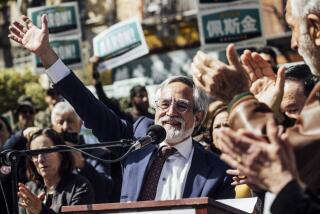Not Yet ‘Blade Runner’ : Anti-Growth Forces, Activist Politicians Define a New L.A.
- Share via
The post-Bradley era has begun in Los Angeles politics.
Four-term, 69-year-old Mayor Tom Bradley--a two-time loser for the California governorship--is now a political lame duck in his own town. Bradley strongly endorsed two City Council candidates in Tuesday’s election--Council President Pat Russell, his long-time ally, and Homer Broome Jr., his protege--and both were soundly defeated.
Though elected 14 years ago as an outsider, Bradley has become part of the city’s Establishment. His vision of Los Angeles as a world-class city seems to consist mainly of high-rise glass office buildings, media events like the Olympic Games and the long-awaited but unnecessary Metro Rail subway.
This, however, is not a vision shared by residents who are concerned with traffic congestion, uncontrolled development, crime protection and the lack of affordable housing.
Their message on Tuesday should be closely studied by the the city’s “growth coalition”--the downtown business Establishment, the developers, the building trades, The Times and the city’s Redevelopment Agency--which embraces Bradley as its cheerleader for its pet plans and projects.
At one time Bradley was a pioneer who helped reform the Los Angeles Police Department and open it up to minorities. But today he has failed to recognize that a new era in the city’s politics is at hand.
This new political terrain has two salient characteristics.
One is the growing neighborhood-based revolt against the city’s policies and priorities. An early indication was the rejection of incumbent Councilwoman Peggy Stevenson two years ago in favor of progressive city planner Michael Woo. Then, last November, voters citywide overwhelmingly approved Proposition U, a slow-growth initiative. And then, on Tuesday, slow-growth advocate and grass-roots candidate Ruth Galanter swept developer-backed incumbent Russell out of her council seat by almost a 60%-40% margin.
In addition to these electoral expressions of citizen feeling, grass-roots groups are now active throughout Los Angeles on quality-of-life issues affecting their neighborhoods.
The United Neighborhoods Organization on the Eastside has fought to a standstill the state prison proposed for that area. The South-Central Organizing Committee has protested the proliferation of liquor outlets, fought the LANCER trash incinerator and on Tuesday rejected Proposition 7, the special tax that would have assessed South-Central residents and businesses for extra police service. On the Westside, the group Not Yet New York has fought high-rise development and challenged city planning policies. Some citizen groups, and possibly Common Cause, are considering an initiative for the 1989 ballot that would promote neighborhood representation by doubling the number of City Council seats. Other groups have called for the establishment of official citizen planning units in each of the city’s neighborhoods.
This citizens’ revolt will not go away. Indeed, it is spreading. The critical question is how to meld legitimate neighborhood concerns and the demands of grass-roots groups into a citywide political force, united around a common set of policies that will replace those of the discredited but still powerful growth coalition.
The other significant political change in Los Angeles is generational. Independent, strong-minded council members in their 30s and 40s--Woo, Richard Alatorre, Gloria Molina and the newly elected Galanter--have joined Zev Yaroslavsky and Joel Wachs on the council. At least two young black activists are planning to run against Gilbert Lindsay, an 86-year-old incumbent who has championed high-rise growth downtown at the expense of neighborhood concerns. City Comptroller Rick Tuttle and City Atty. James Hahn also are part of this activist generation.
These are politicians who came to political maturity in the 1960s and were elected with at least some grass-roots, anti-Establishment support. They have encouraged, and usually have supported, the activities of the neighborhood organizations, and have fought for increased citizen participation.
The challenge for the council members of this activist generation and for the city’s new grass-roots groups is to propose concrete reforms and clear policies speaking directly to citizens’ fears that the quality of life in Los Angeles that they cherish is threatened, and that the future might well resemble the nightmarish urban landscape in the film “Blade Runner.”
The city’s new generation of political leaders must protect neighborhoods from unwanted growth, and at the same time devise new ways for including all of the city’s residents--the homeless, too--in the fruits of Los Angeles’ good life. Ideally, the next mayor, who could well come from this activist generation, should combine a commitment to improving the neighborhood quality of life with a new vision of Los Angeles’ future--one that combines growth and equity. It should be a vision of a friendly and fair city, united in pride in its diverse and livable neighborhoods.
More to Read
Sign up for Essential California
The most important California stories and recommendations in your inbox every morning.
You may occasionally receive promotional content from the Los Angeles Times.










